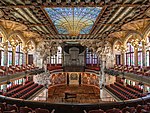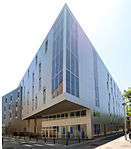Fundació Vila Casas

The Fundació Vila Casas, founded in 1986 by the pharmaceutical entrepreneur Antoni Vila Casas, is a private, non-profit organisation which has the promotion of contemporary Catalan art as its main aim. With five exhibition centers, all part of the Catalan architectural heritage, the foundation has become a platform for exhibiting a permanent collection and holding temporary shows of the artists featured in the collection. The aims of the Fundació Vila Casas in the field of arts is the promotion of the work and the artistic careers of Catalan artists, meaning artists who live or work in Catalonia, by means of: Exhibitions Conferences Donations The awarding of prizes. The promotion of collectors. The providing of museums and galleries for the exhibition of work by contemporary Catalan artists.Since 1998 the headquarters of the Fundació Vila Casas have been located on the first floor of the Modernist building Casa Felip, at Ausiàs Marc Street, number 20, Barcelona. Originally it was the residence of the Felip family, who commissioned the architect Telm Fernández to build it in 1901. Years later it was designated a site of local cultural heritage by the Barcelona city council. The first floor housing the headquarters of the Fundació Vila Casas is not open to the public, but it can be visited with the purchase of the catalogue of the Fundació Vila Casas.
Excerpt from the Wikipedia article Fundació Vila Casas (License: CC BY-SA 3.0, Authors, Images).Fundació Vila Casas
Carrer de Girona, Barcelona
Geographical coordinates (GPS) Address Nearby Places Show on map
Geographical coordinates (GPS)
| Latitude | Longitude |
|---|---|
| N 41.391 ° | E 2.1762 ° |
Address
Carrer de Girona 8
08009 Barcelona
Catalonia, Spain
Open on Google Maps










